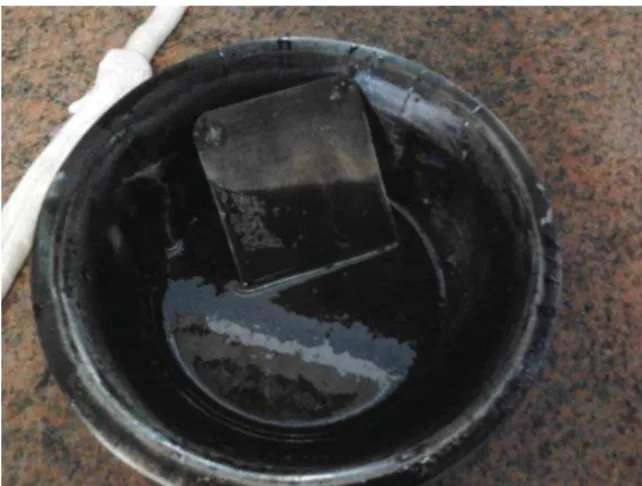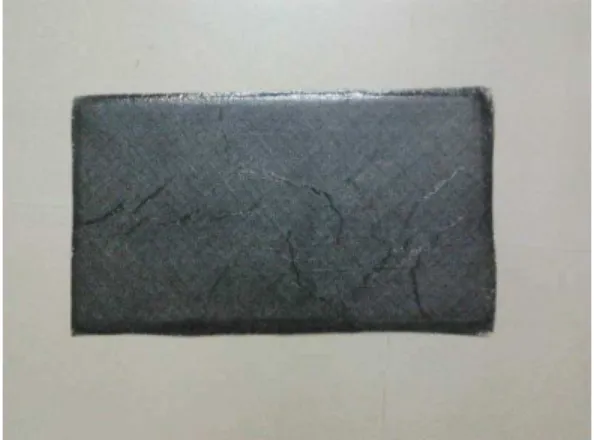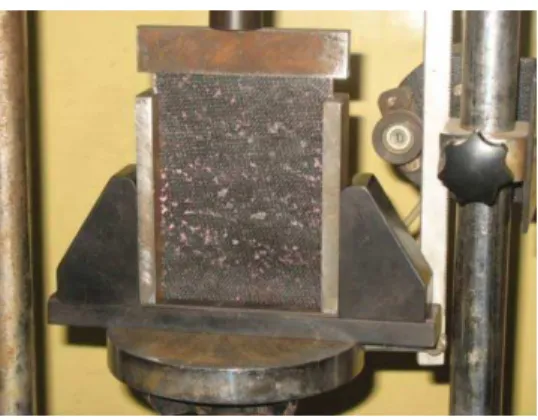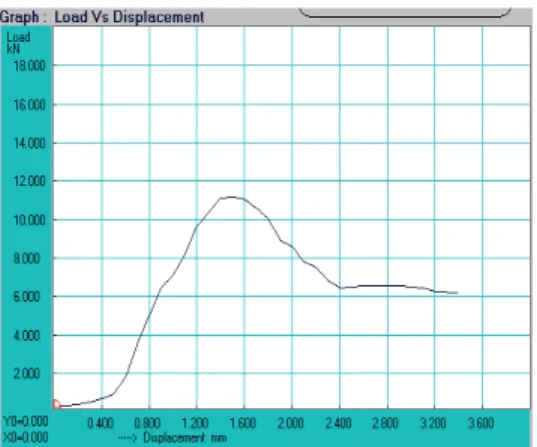Investigation of Impact Performance of
Glass/Epoxy Laminates
Aarthy S
P.G Student, Department of Mechanical Engineering Regional Centre of Anna University, Tirunelveli, Tamilnadu, India
Velmurugan T
Assistant Professor, Department of Mechanical Engineering Regional Centre of Anna University, Tirunelveli, Tamilnadu, India
Abstract- The main objective of this paper is to investigate the effect of properties of resin and fibre on the performance of Glass/Epoxy laminates, a fibre-reinforced composites. Compression failure of composite structures previously damaged by an impact event is due to the propagation of impact-induced damage mechanisms such as interlaminar bonding, constituent micro cracking, sub laminate buckling, as well as the interactions between these mechanisms. This requires fabrication of woven glass fibre epoxy matrix laminates with 1% graphite fillers. Fabrication is done by vacuum bag method followed by curing for specified time in hot air oven. The impact test was carried out for a specific height with given mass and diameter of hemispherical shape impactor. The compression loading was given to the impacted specimen. The damage size was analyzed. Ultimate Compressive residual strength was then calculated.
Keywords – graphite fillers, damage tolerance, compression-after-impact, laminates, mechanical testing
I. INTRODUCTION
In terms of structure, materials can be divided into four basic categories: metals, polymers, ceramics and composites. A composite structure is a material composed of two or more phases combined in a macroscopic scale, whose properties are superior constituent materials, acting in an independent manner. In other words, a composite is a combination of at least two different materials both chemically and geometrically.
Composites are material of choice for light-weight structures due to their excellent weight/strength and weight/stiffness properties. Composite structures may be subjected to low-velocity impacts. Many parameters are involved in impact problems and this induces very different target responses depending on their specific set of interactions. Under the dynamic loading of the material, these unseen damages can become larger and even cause the loss of the material. Because of this, on a layered composite build, foreseeing the damage caused by the impact is very important on design and usage. [19]
II. EXPERIMENTAL PROCEDURE
2.1 Materials –
The fibre used here for the material is E-glass which is a plain weave and is bidirectional. Resin used here is epoxy LY 556 and is mixed with hardener HY 951 in the ratio of 1:10 along with graphite fillers which is a fine black powder of about 400 mesh.
Figure 1. Resin mixed with graphite powder
2.2 Specimen Preparation –
The required specimen dimension is 300×150×3 mm and the fabric is cut accordingly in order to achieve the stacking angle [0/±45/90]s. During hand lay-up, each ply is impregnated with epoxy resin mixed with graphite
fillers. After laying up, the sealant is covered on all four sides of the laminate and its upper surface with a perforated sheet. Surface mat was spread above it to absorb the excess resin. Vacuum of about 550 Hg/mm2 was applied through vacuum valve at one corner of the system which helps in air evacuation. The system was allowed for ambient cure for about 20 hours along with the vacuum pressure. The bagged part was then placed in hot air oven which is shown in fig. 2 at 1200 C for two hours and later allowed to cool at room temperature. The volume fraction of the laminate is shown in table-1and the final laminate is shown in Figure 2.
Table -1 Volume Fraction
Constituents Percentage (%) Fibre 63.4 Resin 32.6 Hardener 3
Figure 2. Glass-Epoxy laminate with graphite filler
III. MECHANICAL TESTS
3.1 Impact Test –
The impact test was carried out to determine the damage resistance of multidirectional polymer matrix composite laminated plates subjected to a drop-weight impact event. In accordance with ASTM D7136, a flat rectangular plate of dimension 100 mm × 150 mm was cut and was subjected to impact damage using a drop tower setup with a hemispherical striker tip and required mass were added. Impactor used here weighs 2 kg with 10 mm diameter. Place the specimen ensuring that it is centered relative to the cut-out. Secure the specimen in place using clamping so that rebounding can be prevented during the impact event.
3.2 Impact Energy –
Impact energy due to the impact event was calculated from the expression as given below, Ei = mgh
where,
Ei = Potential energy of the impactor, J
m = mass of the impactor, kg
g = acceleration due to gravity, 9.81 m/s2 h = drop-height of impactor, m
therefore, Ei = 2×9.81×1
= 19.62 J
3.3 Impact Velocity –
Impact velocity can be found as, Ei = (mvi2)/2
where,
m = mass of the impactor vi = velocity of the impactor
Ei = impact energy
therefore,
19.62 = (2× vi2)/2
Figure 3. Multi-piece support fixture
The damaged piece is installed in a multi-piece support Fixture as in Figure 3 that has been aligned to minimize the loading eccentricities and induced specimen bending. The specimen/fixture assembly is placed between platens and end-loaded under compressive force until failure. Impacted samples were subjected to compression loading based on ASTM D 7137 specification at the rate of 1 mm/min. The speed of testing was set such that the failure is produced within 1 to 10 minutes. Preloading was applied to the specimen/fixture assembly in order to ensure all loading surfaces are in contact and to align the platens. Then the compressive force was reduced and made to re-zero to balance all instrumentation. Loading was done at specified rate until maximum force was reached and it has dropped off about 30% from the maximum.
IV. EXPERIMENTAL RESULTS
After the laminate subjected to impact force, delamination occurs which was then progressively propagated during the application of compressive force. The impacted specimen is shown in Figure 4 and the compression after impact specimen is shown in Figure 5 & Figure 6
Figure 5. Damage after compression loading viewed from front face
Figure 6. Damage after compression loading viewed from back face
From Figures, it is evident that after impact induced compression, the final failure was controlled by sudden extension of the horizontal crack towards the edges of the specimen. Load-displacement curve of impacted composite laminate in compression is shown in Figure 7.
Figure 7. Load-Displacement curve of an impacted composite laminate in compression
Figure 8. Delamination after CAI test
V.CONCLUSION
This paper provided a detailed investigation of compression after impact test response of woven glass/epoxy laminate with 1% graphite fillers. Resin toughness is more influencing parameter than the fibre strength and stiffness. CAI is seen as a matrix dominant failure process. Ultimate compressive residual strength for resin with graphite fillers is more than that without the inclusion of it [12]. Delamination propagation is the critical mechanism that lowers the sublaminate buckling strength of impacted specimens. Delamination propagation extends throughout the width of the specimen between middle plies, which influences the sublaminate buckling. Delamination propagation is marked by mode transition: the loading-direction shear dominated initial impact-induced delamination extends in low amplitude compression loads, which transitions to the lateral shear dominated delamination at higher amplitudes. The delamination extends laterally toward the sides of the specimen. The crack initiate at the back face of the specimen. The constituent cracks propagate laterally and along the thickness direction in shear mode to cause ultimate failure of the specimen under compressive loading.
REFERENCES
[1] Arturas Kersys, Neringa Kersiene, Antanas Ziliukas, “Experimental Research of the Impact Response of E-Glass/Epoxy and Carbon /Epoxy Composite Systems”, Materials Science Vol.16. No.4. 2010
[2] A. Sjogren, A. Krasnikovs, J.Varna, “Experimental determination of elastic properties of impact damage in carbon fibre/epoxy laminates”
Elsevier: Composites Part A 1237-1242, 2001
[3] A.R.. Brindle, X Zhang, “Predicting the Compression-after-impact performance of carbon fibre composites based on impact response”
Cranfield university, 2007
[4] ASTM International, “Standard test method for Measuring the Damage Resistance of a Fibre-Reinforced Polymer Matrix Composite to a Drop-Weight Impact Event” D7136/7136M - 12
[5] ASTM International, “Standard test method for Compressive Residual Strength Properties of Damaged Polymer Matrix Composite plates” D7137/D7137M - 12
[7] D.D.R. Cartie, P.E. Irving, “Effect of resin and fibre properties on impact and compression after impact performance of CFRP” Composites: part A 33 pp.483-493, 2002
[8] Florence Roudolff, Michael Gadke, “Damage tolerance of composite structures for large transport aircraft” Aerosp. Sci. Technol. 4 pp. 23-32, 2000
[9] Giovanni Belingardi, Roberto Vadori, “Low velocity impact tests of laminate glass-fiber-epoxy matrix composite material plates” International Journal of Impact Engineering 27 pp.213-229, 2002
[10] G. Belingardi, M.P. Cavatorta, D.S. Paolino, “Single and repeated impact tests on fiber composite laminates: Damage Index vs. residual flexural properties” Politecnico di Torino 2008
[11] G.J. Short, F.J. Guild, M.J.Pavier, “Post-impact compressive strength of curved GFRP laminates” Composites: Part A 33 pp. 1487-1495, 2002
[12] Hao Yan Oskay, Arun Krishnan, Luoyu Roy Xu, “Compression After Impact Response of Woven Fiber-Reinforced Composites”
Vanderbilt University, 2010
[13] John P. Dear, Samuel A. Brown, “Impact damage processes in reinforced polymeric materials” Composites Part A 34 pp. 411 – 420, 2003
[14] N.K.Naik, R.Ramasimha, H.Arya, S.V. Prabhu, N.ShamaRao, “Impact response and damage tolerance characteristics of glass-carbon/epoxy hybrid composite plates, Bethel: Society for experimentel mechanics, p.198-201, 2000
[15] N.K.Naik, Y.Chandra Sekher, Sailendra Meduri, “Damage in woven-fabric composites subjected to low-velocity impact” Indian Institute of Technology, Powai, Mumbai, 1998
[16] N.K.Naik, R.Ramasimha, “Estimation of compressive strength of delaminated composites” IIT Mumbai, 1998
[17] N.Rajesh, Mathivanan, J.Jerald, “Experimental Investigation of Woven E-Glass Epoxy Composite Laminates Subjected to low-velocity at different levels” Journal of minerals and materials characterisation & engineering, vol.9, no.7, pp.643-652, 2010
[18] N .Rajesh, Mathivanan, J.Jerald, “Interlaminar fracture toughness and low-velocity impact resistance of woven glass epoxy composite laminates of EP3 Grade” Journal of minerals and materials characterisation & engineering, vol.11, no.3, pp.321-333, 2012
[19] Rajeshpandian R, Muruganandhan R, “ Experimental and finite element analysis of mechanical response on unidirectional glass fibre epoxy laminate” Anna University Chennai, 2009
[20] Ramazan Karakuzu, Emre Erbil, Mehmet Aktas, “ Damage prediction in glass/epoxy laminates subjected to impact loading” Indian Journal of Engineering and material Sciences, vol.17, pp.186-198, 2010
[21] Robin Olsson, “Analytical prediction of large mass impact damage in composite laminates” Composites: Part A 32 pp.1207-1215, 2001




